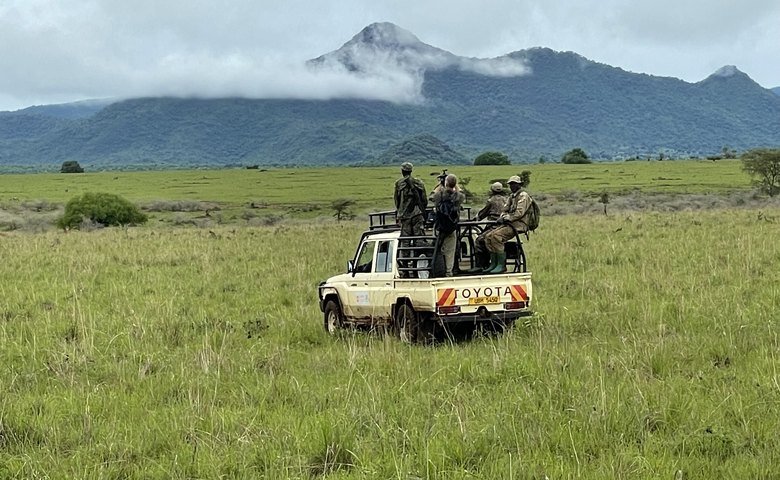5 Years Of Progress And Challenges - Murchison Falls National Park, Uganda
Since 2018, Global Conservation has been supporting the work of Uganda Conservation Foundation (UCF) and the Uganda Wildlife Authority (UWA) to restore wildlife, effective park management, and tourism numbers in Murchison Falls National Park, Uganda.
Murchison Falls National Park was once considered the Jewel of Africa with hundreds of thousands of visitors before the region fell to civil war which decimated nearly 90% of the park’s biodiversity – elephants, hippos, lions and hundreds of other species.
Uganda’s largest and oldest national park is over 500,000 hectares and was once the most visited park in Africa and home to the highest megaherbivore biomass on the continent. During the late 1970s to the year 2000, the park suffered extreme poaching, with elephant numbers dropping from 16,000 to under 500. The impact of poaching on other herbivores and the carnivores was just as dramatic – a complete collapse.
Since the turn of the millennium, the core tourism area of MFNP (3%) has stabilized, resulting in a steady recovery in tourist numbers. Outside of the core area, though, poaching has remained extreme especially in the 97% of the national park outside the tourism area. Vast areas remain vulnerable to poaching blocking wildlife growth and ability to distribute across the landscape.
Deploying Global Park Defense
Over the past 5 years, UCF and UWA, with Global Conservation support, have built out critical new infrastructure and professional park management and protection systems, deploying Global Park Defense across nearly 85% of the national park. The Global Park Defense program has achieved critical outcomes towards park and wildlife protection to stop wildlife poaching and enable biodiversity recovery:
Park-wide Communications
Five new digital radio towers now enable communications to all vehicles, 18 ranger stations and patrol teams handsets.
Community Protection
80 Community Scouts provide support to UWA, including rotations to support ranger stations and patrols. The program employs youth from the north of the park who are selected to undertake vocational college courses in hydraform brick making, industrial painting, tractor operations, installation of water tanks and guttering, fencing, tree nursery set-up and tree management.
In addition, the Community Scout assist with patrolling and surveillance. This is especially significant given that they come from communities that tend to have negative perspectives toward UWA and the national park. Their attitudes have now changed, and they are now trusted park ambassadors within their communities.
New Joint Operations Command Center (JOCC)
For the first time, the national park has a complete command center with Operations Center, Intelligence, Police Station, Jail, Armory, Confiscations Warehouse and independent Solar Power and Generator.
EarthRanger Real-Time Protection System
EarthRanger provides a real-time protected area management solution that aids protected area managers, ecologists, and wildlife biologists in making more informed operational decisions for wildlife conservation. EarthRanger collects, integrates and displays all historical and real-time data available from a protected area—including wildlife, ranger patrols, spatial data, and observed threats.
EarthRanger is a proven ‘Force Multiplier’ for security operations with a visualization capability that allows managers to gain a real-time, in-depth understanding of activities related to poaching and other threats. EarthRanger informs patrol planning and increases patrol effectiveness as well as enabling analysis and deeper insight into meaningful trends, such as poaching interdictions, animal behavior and the national park’s responses.
EarthRanger can be viewed on a big screen in an operations center, on a tablet or on a phone. Data can be collected from the field using the EarthRanger mobile application, which can function as real-time tracking, event reporting, and starting and stopping of patrols on devices for team members without radios or satellite trackers.
Expanded Patrol Operations
Especially during Covid when park revenues collapsed, Global Conservation’s ongoing support enabled continued Ranger patrolling in all 9 sectors of the national park, replenishment of rations and water, as well as fuel and vehicle maintenance.
Professional Training and Equipment
With major upgrades to Ranger Kits and Ranger Stations, including solar power and kitchens, beds and bath. All Murchison Falls Rangers received Junior Leadership training including human rights and medical, as a foundation before Special Skills training.
Aerial Wildlife Surveys
For the first time in Africa, an aerial survey used imaging and artificial intelligence to provide an estimated population count for a major national parks giving an accurate count of elephants, hippos, buffalos and other herbivores.
Traditional aerial elephant surveys rely on human spotters counting elephants one by one while looking out the window. With the latest airborne imaging systems, baseline wildlife population surveys and detailed land use and deforestation maps can be automatically generated for park and wildlife management, community development and wildlife corridor planning.
Critical Outcomes - Murchison Falls Recovery
Unified Command and Control for all park sectors enabling effective planning and targeted patrolling against wildlife poaching.
Collaboration for Park and Wildlife Protection now allows multiple team members and teams from neighboring protected areas to collaborate and share data about poaching and wildlife tracking to activate joint patrol missions and responses to illegal activities.
Completed Joint Operations Command Centre (JOCC) was built in order to combine resources and capabilities together into a coordinated and well-managed system with an armory, police station and cell block, guard room, storage facilities, radio and internet towers, solar power and generator, and operational assets and supplies.
Intensive Patrolling Coverage over tens of thousands of miles and hundreds of operations annually, Understaffed Ranger teams arrested over 460 poachers in 2022 and removed 8 tons of traps and snares.
New Marine Teams and Boats now support five ranger stations on the shorelines where the majority of wildlife poachers are entering the national park. In the Delta, the core tourism area, threats to the park come from the Nile River and Lake Albert, where poachers disguised as fishermen would wait for patrols to pass and enter the park to lay thousands of snares. Forty rangers were trained in boat operations, safety and rescue techniques and patrol operations from the waterways. Since 2018, 34 metric tonnes of wire snares have been removed from the Delta.
Reduced Wildlife Poaching to less than 5% of species killed annually, despite thousands of highly skilled poachers taking lion, elephant, hippo and buffalo, as well as other game meat species with guns, traps, snares and spears.
Reduced Human Wildlife Conflict through proactive mitigation using timely, automated alerting and seamless recording of incidents to enable managers to reduce conflict and help communities and human settlements coexist with wildlife.
Massive Snare Removal over 12,000 kilos a Year, particularly important across the entire park as they indiscriminately kill all species large and small. The rare Rothschild giraffe, lions and elephants were being caught in very high numbers, and were suffering agonizing deaths and injuries. One third of the elephants in the area had snare injuries, including some with their trunks severed off.
Park Expansion discussions are now underway to add the Budongo Forest Reserve of nearly 40,000 hectares, with abundant populations of chimpanzees, to make Murchison Falls National Park even more competitive as a preferred tourist destination in Africa, and broaden and deepen economic opportunities for local communities.
Biodiversity Recovery in the past five years has seen all species increase comparing to near total collapse just decades before:
Elephants - Over 1,200
Rosthschild’s Giraffes - Over 600
Hippos - Over 2,000
Lions - Nearly 400
Buffalo - Over 2,400
Cobb - Almost to Target
Wildlife Monitoring using satellite collars on lions and elephants are registered on the EarthRanger system so they can be always monitored to see how they are using the habitat. As elephants roam outside the national park, communities can be alerted in advance to discourage the elephants from crop raiding. If the collar stays static for a while, an alert will be made to deploy to see what has happened to the lion.
Prestigious Awards were given to the Murchison Falls team. Julius Obwona, Murchison’s Warden in Charge of Law Enforcement, was selected as the Duke of Cambridge – Prince William – as Tusk Africa Ranger of the Year. In addition, the Chief Park Warden of Murchison Falls was given a Ugandan Presidential Award and later became the Executive Director of the National Forestry Authority. UCF’s Project Manager Patrick Agaba was also named the David Shepherd Wildlife Foundations Conservation Hero.
Global Conservation is extremely proud and pleased with our investment in deploying Global Park Defense and towards the recovery of Murchison Falls National Park. We thank the leadership of Michael Keigwin, Director of UCF for his critical leadership to make this possible, the UCF team and UWA.
By building capacity of the Uganda Wildlife Authority who runs the national park, and working to integrate local communities into park and wildlife protection, we are supporting the most sustainable long-term strategy for park and wildlife protection.
The future of Uganda depends on success of this model as they will never turn over their national parks to concessions and tourism continues to grow as the countries most important economic driver reaching the #1 position making up nearly 8% of Uganda’s GDP.
“The JOCC and LEOC has been an incredible success. We cannot thank Global Conservation and your Board enough. The project has revolutionized the parks operations and even now, in pretty dark times, the level of motivation is huge. Global Conservation was an incredible partner in helping this all become a reality. Murchison Falls continues to recover at an extraordinary rate, and all of your help will help make that sustainable. We can’t thank all of our Recovery of Murchison Falls Protected Area donors enough. Seeing the aerial survey results was proof that everything we have done and continue to do is making a massive difference. There are not many places where wildlife numbers have grown so much, and will continue to do so.”
- Uganda Conservation Foundation
Global Conservation would particularly like to thank our co-funders including International Elephant Foundation, Tusk Trust and the David Shepherd Wildlife Foundation. As well, we want to appreciate the donation of software and support by Allen AI2 of the EarthRanger park protection and management system.
Murchison Falls National Park
Murchison Falls National Park is Uganda's largest national park. It measures approximately 3,893 square kilometres (1,503 sq mi). The park is bisected by the Victoria Nile from east to west for a distance of about 115 kilometres (71 mi). The park is the location of the Murchison Falls, where the waters of the Nile flow through a narrow gorge only 7 metres (23 ft) wide before plunging 43 metres (141 ft).



















